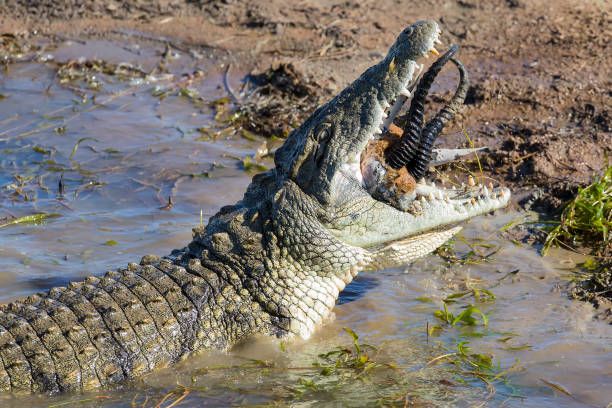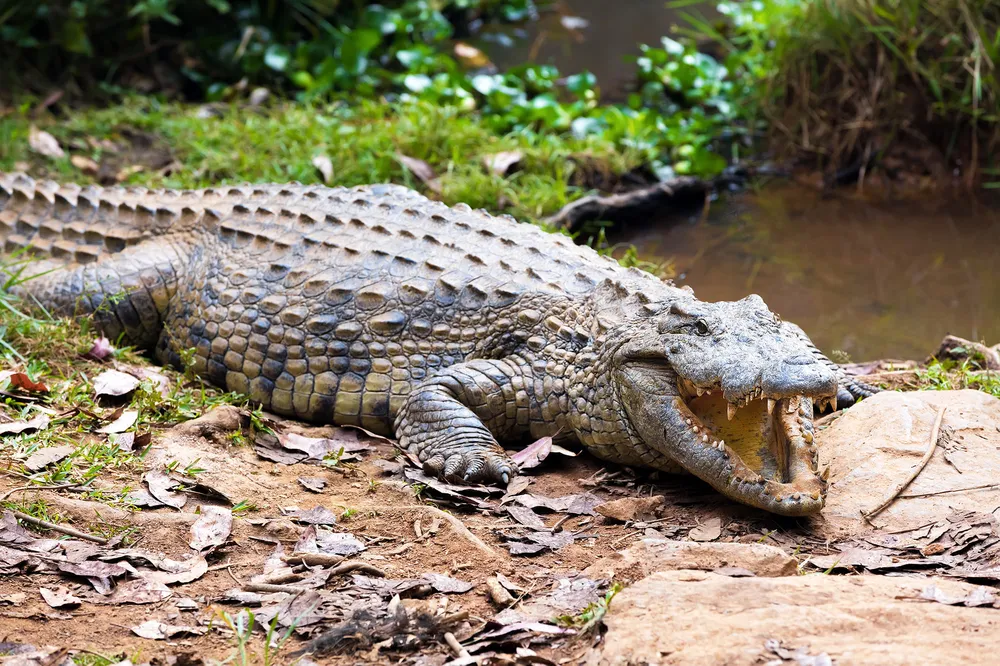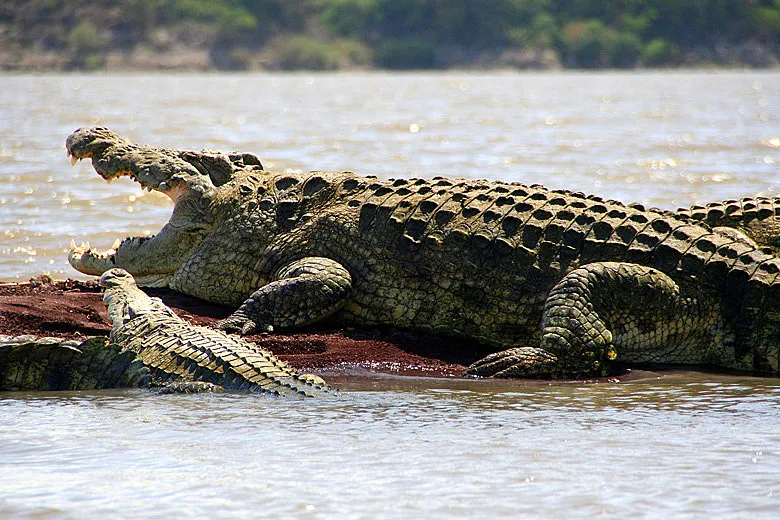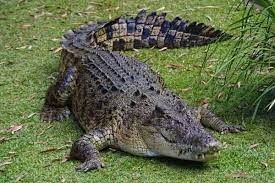Nile Crocodile Ecological Role
Nile Crocodile Ecological Role The Nile crocodile (Crocodylus niloticus) is one of Africa’s most iconic reptiles and plays a crucial role in its ecosystems. Found across much of sub-Saharan Africa, these reptiles thrive in rivers, lakes, and marshlands. As one of the largest crocodilian species, they are feared yet admired for their power and adaptability. But beyond their physical presence, Nile crocodiles hold a significant place in maintaining the health and balance of their environments. This article explores the various ecological roles they play, emphasizing their importance for biodiversity and ecosystem stability.
Apex Predator

The Nile crocodile occupies the top of the food chain in many of its habitats, making it an apex predator. These powerful reptiles prey on a wide range of animals, including fish, birds, reptiles, and mammals, from small rodents to large ungulates. This predation is critical in regulating prey populations, preventing overpopulation of certain species and thus maintaining a balanced ecosystem. By controlling the numbers of herbivores, they indirectly protect vegetation from overgrazing, which is vital for maintaining the structure of aquatic and riparian ecosystems.
Table: Ecological Roles of the Nile Crocodile
| Ecological Role | Description | Impact on Ecosystem |
|---|---|---|
| Apex Predator | The Nile crocodile preys on fish, birds, reptiles, and mammals, including large ungulates. | Regulates prey populations, prevents overpopulation, and maintains species balance in both aquatic and terrestrial environments. |
| Scavenger | Consumes dead animals (carrion) in addition to hunting live prey. | Contributes to nutrient recycling, helps decompose organic matter, and prevents the spread of disease from decaying bodies. |
| Keystone Species | Has a disproportionately large effect on its environment, influencing prey behavior and population dynamics. | Shapes the ecosystem structure, maintains balance through predation, and indirectly influences biodiversity. |
| Habitat Engineer | Creates and maintains waterholes, especially during dry seasons. | Provides essential water sources for other species during dry periods, supporting wildlife survival. |
| Symbiotic Relationships | Engages in mutualistic interactions with species like Egyptian plovers that clean their teeth. | Benefits both the crocodile (by maintaining dental health) and the birds (which get food), fostering interspecies cooperation. |
| Control of Invasive Species | Preys on and regulates invasive species that threaten the balance of the ecosystem. | Helps prevent the disruption of local ecosystems by controlling invasive populations. |
| Nutrient Recycling | Breaks down organic matter from carrion and returns nutrients to aquatic ecosystems. | Supports the growth of aquatic plants and other organisms, maintaining ecosystem productivity and health. |
| Human Impact Mitigation | Regulates species that could overpopulate and become pests in human environments. | Helps control pests or overabundant species, indirectly benefiting agriculture and human settlement areas. |
Their predatory habits also influence the behavior of prey species, shaping how and where animals like antelope and zebras access water sources. This behavioral modification helps create a more dynamic ecosystem with varying patterns of species distribution and resource use.
Scavenging and Nutrient Recycling
In addition to hunting live prey, Nile crocodiles are opportunistic scavengers. They play an essential role in cleaning up their environment by feeding on carrion—animals that have already died. This behavior is particularly beneficial to the ecosystem as it prevents the spread of disease from decaying bodies and helps recycle nutrients back into the environment.

When crocodiles consume dead animals, they help decompose organic matter in aquatic ecosystems, ensuring that nutrients are returned to the water, where they can support other life forms. This nutrient recycling is essential for the productivity of river and lake systems, contributing to the growth of fish populations and aquatic plants, which in turn support other wildlife.
Keystone Species

Nile crocodiles are considered a keystone species, meaning their presence and actions have a disproportionate impact on the ecosystems they inhabit. Their role as apex predators influences the population dynamics of many species, which has cascading effects on the entire food web. Without crocodiles, certain prey species would thrive unchecked, potentially leading to ecosystem imbalance.
Their presence also shapes the behavior of other species, as many animals modify their activities to avoid becoming prey. This fear-driven behavior, known as the “landscape of fear,” can affect how animals use different habitats, distribute themselves, and even influence plant growth by altering grazing patterns.
Habitat Engineers

Beyond their predatory role, Nile crocodiles are also habitat engineers. By creating and maintaining water holes, especially during dry seasons, they provide essential resources for many other species. These water holes become vital for animals seeking water when other sources dry up. Many species of birds, mammals, and reptiles rely on these crocodile-made or maintained areas for survival during harsh conditions.
Moreover, Nile crocodile nests, which they build by digging into sandy riverbanks, provide shelter not just for their own offspring but also for other species. For instance, various bird species may nest near or within crocodile nests, benefiting from the protection the crocodiles provide from other predators.
Interaction with Other Species
Nile crocodiles have a range of interactions with other species, particularly through their predator-prey relationships. By preying on a variety of species, they help control populations of both native and invasive species. For example, they keep populations of invasive fish or small mammals in check, preventing these species from disrupting the natural balance.
One of the more interesting interactions involves birds, such as Egyptian plovers, which are known to engage in a form of symbiosis with crocodiles by cleaning their teeth. These birds pick pieces of food lodged in the crocodile’s teeth, benefiting from the meal while the crocodile gets its mouth cleaned.
Impact of Human Activities

Human activities pose significant threats to Nile crocodiles and the ecological roles they fulfill. Poaching for their skin, meat, and other products, as well as habitat destruction from dam construction, agriculture, and urbanization, are some of the main factors driving their population decline. As Nile crocodile numbers decrease, so too does their ability to regulate prey populations, maintain water bodies, and recycle nutrients. This leads to cascading effects throughout the ecosystem, from uncontrolled prey populations to less healthy waterways.
The decline in crocodile populations can also result in the loss of other species that depend on crocodile-created habitats, such as water holes or nesting sites. It is essential, therefore, to implement conservation measures to protect Nile crocodiles, ensuring that they continue to fulfill their critical ecological roles.
Conclusion
Nile crocodiles are not just fearsome predators; they are vital contributors to the health and balance of the ecosystems they inhabit. Their roles as apex predators, scavengers, keystone species, and habitat engineers demonstrate their importance in maintaining the ecological integrity of Africa’s rivers and lakes. As human pressures continue to threaten their survival, it becomes increasingly important to recognize and protect their place in the natural world. Preserving Nile crocodiles ensures that they can continue to support biodiversity, maintain ecosystem balance, and provide essential resources for countless other species.
Tips for Writing an Effective Article on the Ecological Role of the Nile Crocodile
Research Thoroughly
- Understand the biology, behavior, and habitat of Nile crocodiles before writing. Reliable sources such as scientific papers, wildlife organizations, and reputable websites provide valuable information.
Explain Ecological Terms
- Define key ecological terms (e.g., apex predator, keystone species) for readers who may not be familiar with them. Keep definitions simple and accessible.
Use Real Examples
- Incorporate specific examples of how Nile crocodiles impact their environment, such as their role in controlling fish populations or maintaining water holes. Real-world examples make the article more engaging.
Balance Scientific and Casual Language
- While the topic is scientific, use language that is easy to understand. Avoid jargon, and if technical terms are necessary, provide brief explanations.
Emphasize Conservation Issues
- Highlight the impact of human activities on Nile crocodile populations and why conservation is essential. This adds relevance and urgency to the article.
Include Visuals
- Where possible, use images or diagrams (such as maps of their habitat or photos of Nile crocodiles in action) to break up the text and make it more visually appealing.
Organize the Content Logically
- Follow a clear structure, starting with an introduction, followed by sections on their predatory role, scavenging, interactions with other species, and ending with a conclusion on their ecological importance.
Use Engaging Headlines
- Use descriptive subheadings like “Apex Predator” or “Habitat Engineers” to keep readers interested and help them navigate the article easily.
Relate to the Reader
- Tie in how Nile crocodiles’ roles in ecosystems indirectly benefit humans, such as by controlling pest populations or maintaining healthy aquatic ecosystems that support fishing communities.
Review and Edit
- After writing, review the article for clarity, grammar, and flow. Ensure each section smoothly transitions into the next, and double-check your facts.
FAQs Nile Crocodile Ecological Role
What is the ecological role of the Nile crocodile?
Nile crocodiles play a critical role as apex predators in their ecosystems. They help regulate populations of various prey species, contribute to nutrient recycling by scavenging, maintain waterholes that support other wildlife, and indirectly shape the behavior of other species through their presence.
Why are Nile crocodiles considered apex predators?
Nile crocodiles are considered apex predators because they sit at the top of the food chain. They prey on a wide range of animals, from fish to large mammals, without having any natural predators themselves. This makes them crucial in controlling prey populations and maintaining the balance of ecosystems.
How do Nile crocodiles contribute to nutrient recycling?
Nile crocodiles are opportunistic scavengers, meaning they feed on dead animals. By consuming carrion, they help decompose organic matter and recycle nutrients back into the ecosystem, promoting the growth of aquatic plants and other organisms that benefit from these nutrients.
What is a keystone species, and why are Nile crocodiles considered one?
A keystone species is an organism that has a disproportionately large effect on its environment relative to its abundance. Nile crocodiles are considered a keystone species because their actions, such as predation and habitat creation, significantly shape the structure and function of ecosystems, influencing other species and maintaining ecological balance.
How do Nile crocodiles act as habitat engineers?
Nile crocodiles are habitat engineers because they create and maintain waterholes, especially during dry seasons. These waterholes become critical for other wildlife to survive in dry conditions. Additionally, their nesting behavior often creates opportunities for other species to use the same areas for shelter.
Do Nile crocodiles interact with other species besides prey?
Yes, Nile crocodiles engage in interesting interactions with other species beyond their prey. For example, some birds, like the Egyptian plover, have a symbiotic relationship with crocodiles by cleaning food remnants from their teeth. This mutualistic behavior benefits both the birds and the crocodiles.
What impact do human activities have on Nile crocodiles?
Human activities, such as poaching, habitat destruction, and water pollution, negatively affect Nile crocodile populations. These actions reduce their numbers, which disrupts their ecological role, leading to imbalances in prey populations and declining health of aquatic ecosystems.
Why is it important to conserve Nile crocodiles?
Conserving Nile crocodiles is important because they are key to maintaining the balance of the ecosystems they inhabit. Their roles in controlling prey populations, recycling nutrients, and providing habitats for other species are essential for ecosystem health. If their populations decline, it could result in cascading negative effects on biodiversity and ecosystem stability.
How do Nile crocodiles indirectly benefit humans?
Nile crocodiles help control populations of certain species that could become pests or overpopulate without predators. Their role in maintaining healthy aquatic ecosystems also supports human activities such as fishing, as a balanced ecosystem helps ensure stable fish populations.
Where can Nile crocodiles be found?
Nile crocodiles are native to much of sub-Saharan Africa and are commonly found in rivers, lakes, marshlands, and wetlands. They are particularly associated with the Nile River, but their range extends across various parts of the continent where freshwater habitats are present.